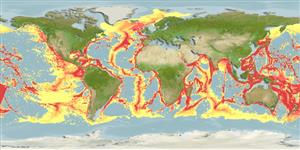Common names from other countries
Classification / Names / Names
ชื่อสามัญ | ชื่อพ้อง | Catalog of Fishes (gen., sp.) | ITIS | CoL | WoRMS
Environment: milieu / climate zone / depth range / distribution range
นิเวศวิทยา
ผิวน้ำ; ระดับความลึก 200 - 4000 m (Ref. 96968). Subtropical
Worldwide in tropical and subtropical waters.
Length at first maturity / ขนาด / น้ำหนัก / Age
Maturity: Lm ? range ? - ? cm Max length : 16.0 cm TL เพศผู้/กระเทย; (Ref. 96968)
Maximum depth from Ref. 110525. Depth range from 200 to 1,000 m. These small pelagic octopuses typically occur over deeper water as adults. Young animals tend to occur in the shallower end of the range. As members of this species reach sexual maturity the iridescence of the digestive gland and eyes is lost, and animals migrate to deeper darker waters in the later stages of the life cycle. Nearly mature males have salivary glands that are much larger than those of comparable females. Salivary products may be used as chemical attractant for females. The female light organ may be used for reproductive signalling to males (Ref. 96968).
Life cycle and mating behavior
วัยเจริญพันธุ์ | การสืบพันธุ์ | การวางไข่ | เซลสืบพันธ์ของเพศเมีย(ไข่) | ความดกของไข่ | ตัวอ่อน
Members of the class Cephalopoda are gonochoric. Male and female adults usually die shortly after spawning and brooding, respectively. Mating behavior: Males perform various displays to attract potential females for copulation. During copulation, male grasp the female and inserts the hectocotylus into the female's mantle cavity where fertilization usually occurs. Life cycle: Embryos hatch into planktonic stage and live for some time before they grow larger and take up a benthic existence as adults.
Turgeon, D.D., J.F. Quinn Jr., A.E. Bogan, E.V. Coan, F.G. Hochberg, W.G. Lyons, P.M. Mikkelsen, R.J. Neves, C.F.E. Roper, G. Rosenberg, B. Roth, A. Scheltema, F.G. Thompson, M. Vecchione and J.D. Willams. 1998. (Ref. 1667)
IUCN Red List Status (Ref. 130435)
CITES status (Ref. 108899)
Not Evaluated
Not Evaluated
Human uses
| FishSource |
เครื่องมือ
ข้อมูลเพิ่มเติม
Age/SizeการเจริญเติบโตLength-weightLength-lengthสัณฐานวิทยาตัวอ่อนอุดมสมบรูณ์
แหล่งที่มาจากอินเตอร์เน็ต
Estimates based on models
Preferred temperature
(Ref.
115969): 2.5 - 7.7, mean 4.1 (based on 3355 cells).
Price category
Unknown.
